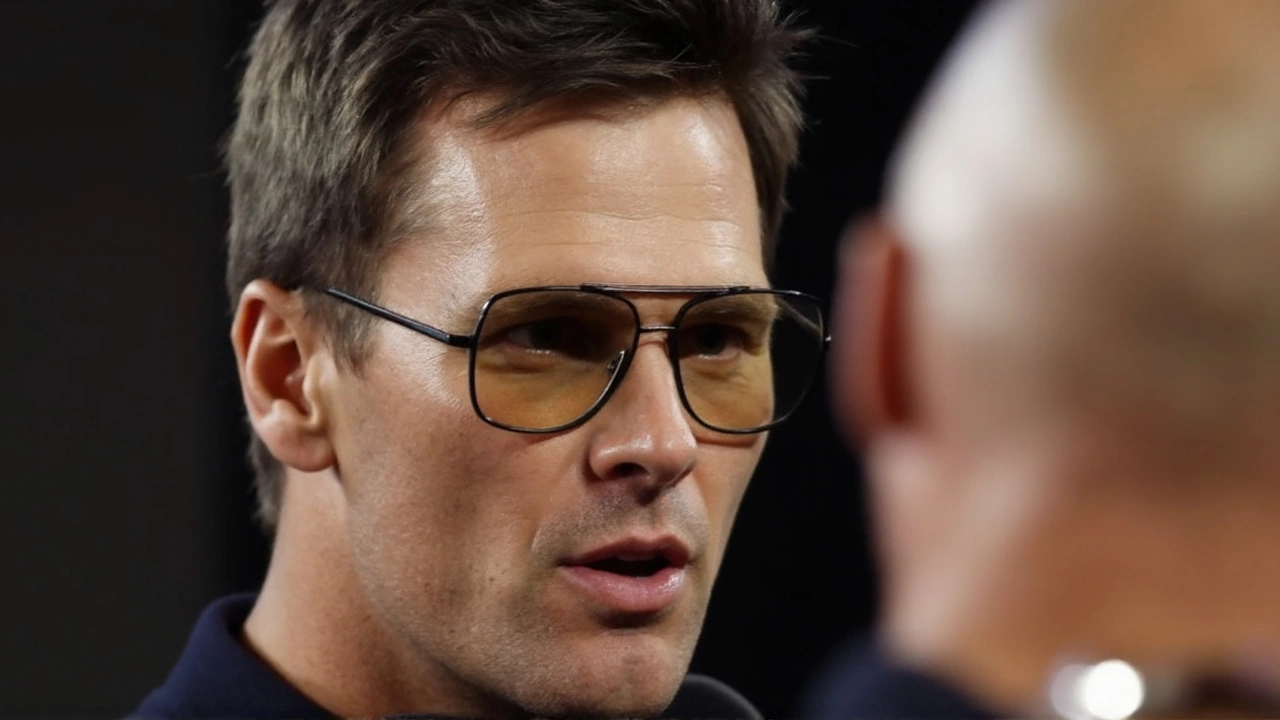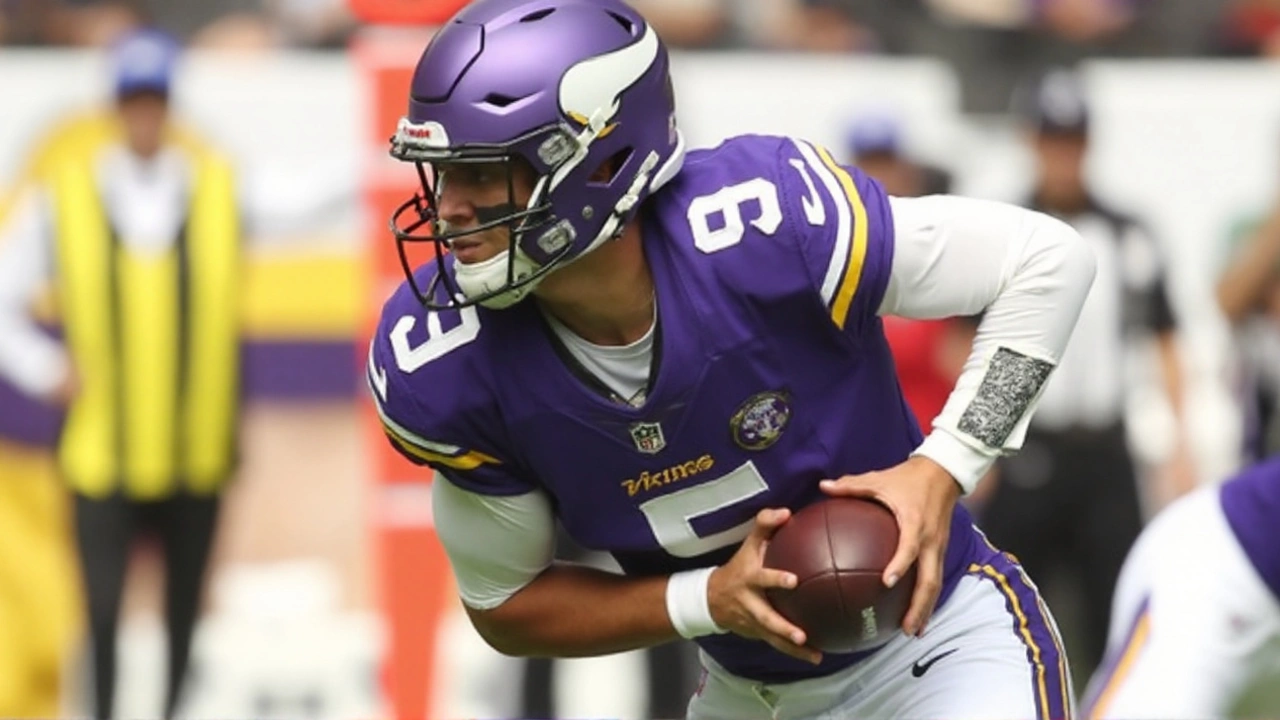By Ariq
Three hundred sixty-four days after his last college snap, J.J. McCarthy stepped into the NFL’s brightest regular-season stage and turned a bad night into a statement. Down 17-5 in the fourth quarter on Monday Night Football, the Minnesota Vikings rookie quarterback ripped off three straight touchdown drives and walked away with a 27-20 win over the Chicago Bears. First start. Primetime. A rivalry. And a comeback that felt bigger than Week 1.
McCarthy didn’t arrive at this moment on a straight path. Drafted 10th overall in 2024, the former Michigan star had knee surgery in August that wiped out his entire rookie season. That meant a gap of nearly a year between his last meaningful throw and his NFL debut. For three quarters, the gap showed. He was late on reads, the ball came out tentative, and the Bears’ defense—energized by their own hyped rookie quarterback, Caleb Williams—kept Minnesota off balance.
Then the game flipped. With 15 minutes left and an offense stuck in mud, McCarthy found rhythm and confidence. Minnesota’s play-caller Kevin O’Connell shifted into a tempo-heavy, motion-rich approach that simplified reads and leaned into what McCarthy did best at Michigan: quick decision-making, accurate throws into windows, and controlled aggression.
How the comeback unfolded
The fourth quarter was a clinic in composure and timing. The Bears had dictated most of the night, and a 17-5 lead looked safe. McCarthy had other plans.
- Touchdown No. 1: On a 17-yard strike, McCarthy threaded a ball to Justin Jefferson, beating tight coverage and finally cracking the end zone. The timing on the throw—patience to let the route develop, decisiveness to hit it—was the first real sign his poise had caught up to the moment.
- Touchdown No. 2: On the next scoring drive, he found Jefferson again, this time on a 13-yard dart over the middle. The “J.J. to J.J.” connection landed twice in a hurry, and Minnesota suddenly had momentum and swagger.
- Go-ahead play: After the defense forced a three-and-out, McCarthy attacked. He dropped a perfectly placed deep ball down the right sideline to Aaron Jones for a 27-yard touchdown, then hit Adam Thielen for the two-point conversion. With 9:46 to go, Minnesota led 20-17—and McCarthy looked like a different player.
- The dagger: On the next possession, the Vikings leaned on a nine-play, 68-yard march that ended with McCarthy keeping on a read option and sprinting into the end zone. "It was the perfect play call," he said later. It also showcased the athletic piece of his game that survived the knee surgery and months of rehab.
Chicago made it interesting late—Caleb Williams hit Rome Odunze on an 8-yard touchdown to close the gap—but the Bears couldn’t finish their own rally. The clock ran out with Minnesota holding the kind of win that resonates in a locker room.
What stood out wasn’t just the box score—two touchdown passes, one rushing score, all in the final quarter—it was McCarthy’s control of the huddle when everything tightened. Bad nights beat rookies. Primetime nerves do, too. He took the opposite turn, playing faster and cleaner as the pressure spiked.
There was a clear shift in how Minnesota attacked. Early on, the Vikings asked McCarthy to play static, with predictable drops and shallow throws that the Bears smothered. In the fourth, they changed the picture: more pre-snap motion to tip coverages, quicker throws to rhythm receivers, selective deep shots off play-action, and a dash of quarterback run to punish overaggressive edges. The tweaks gave him clearer answers—and he hit them.
That balance also unlocked Minnesota’s stars. Jefferson’s first touchdown was all timing and precision; the second was trust. The sideline toss to Jones showed touch and fearlessness. The two-point conversion to Thielen looked like a veteran using a simple leverage read in the red zone. None of it was fluky. It was scripted, then executed with conviction.
And the defense did its part when it mattered. The stop that triggered Jones’s go-ahead touchdown came after the Bears had a chance to squeeze the game. One three-and-out later, McCarthy had the ball—and the runway—to flip it.

Why it matters for Minnesota — and Chicago
For the Vikings, this wasn’t just a fun opener. It was a proof-of-concept. They spent a first-round pick on McCarthy after winning a national title at Michigan, trusting traits that don’t always pop in highlight reels: accuracy, calm feet, quick processing, and a knack for big moments. His college line—6,226 passing yards, 49 touchdowns, and only 11 interceptions—suggested a quarterback who protected the ball and thrived in structure. Monday night showed how that translates when the structure wobbles.
Equally important was the context: he hadn’t played a snap that counted in a year, and his first one back came under the Monday night lights. The pressure to be perfect can bury a young quarterback. McCarthy didn’t chase perfection. He took what the defense gave him in the fourth, and when the game begged for a shot, he took it.
The Vikings’ staff will quietly love the sequencing. They didn’t ask him to be the hero early. When it was time, they let him drive. The late keeper on the read option wasn’t just window dressing—it said the knee is trustworthy, the speed is there, and the staff is willing to put the ball in his hands in the red zone.
Head coach Kevin O’Connell called it resilience and poise afterward, and that tracks. If you’re building a quarterback, Week 1 is less about gaudy stat lines and more about handling chaos. McCarthy did that. He took a game that was getting away and flattened it into clear downs, clean throws, and timely risks. That’s the temperament front offices bet on when they take a passer in the top 10.
There’s also the history piece. McCarthy became just the fourth quarterback in the last 20 seasons to make his first career start on Monday Night Football in Week 1, and the trend held—each of the previous three guys in that exact spot won, a group that includes Philip Rivers. It’s an odd little club, but it captures the central point: some players meet the moment.
On the other side, the Bears saw both the promise and the tax of playing a rookie quarterback. Caleb Williams delivered a late touchdown to Rome Odunze and showed flashes of the arm talent that made him the top pick, but Chicago’s offense went quiet at the worst time. That fourth-quarter three-and-out was the hinge of the night. One first down there, and the Vikings don’t get the short field and tempo they used to take the lead.
Chicago will point to missed chances and field position. The defense did real work for three quarters, crowding throwing lanes and forcing the Vikings into checkdowns and punts. Once Minnesota sped up, the Bears lost the leverage battle on the perimeter and couldn’t keep Jefferson and Jones in front of them. That’s a film-room fix, but it stings in a rivalry opener.
Zoom out, and the matchup looked like what it was billed to be: two franchises trying to solve quarterback for the long term with rookies who bring different skill sets. McCarthy, smooth in the structure of a system; Williams, a creator who can tilt the field when plays break down. Monday night favored the former. These meetings tend to balance out over time.
For McCarthy personally, the night put a thumbtack in the map. Last August he was on an operating table getting a torn meniscus repaired. Monday he was reading one-high versus two-high, firing on the move, and willing his team out of a 12-point hole. The rehab was the part fans didn’t see: months of strength work, balance training, footwork rebuilds, and the mental grind of watching, not playing. You don’t shake off that rust in a quarter, but he did in a fourth.
It also sets a tone inside Minnesota’s building. Teammates now have a fourth quarter they can trust when things get tight. Jefferson saw the ball in the biggest spots. Jones fit smoothly as a receiving threat out of the backfield, a dimension that forces linebackers to choose between the shallow cross and the flat. Thielen’s conversion reminded everyone he still wins on leverage. Those are sustainable levers, not one-off tricks.
The coaches have tape to teach from, too. The early stalls showed where protections and route spacing need cleanup. The late success showed which concepts unlocked McCarthy: quick-game slants and sticks, play-action crossers, the slot fade, the sideline sail, and the occasional deep shot off a max protect look. Add a few designed keeps to keep edges honest, and you’ve got a template.
None of this means the Vikings have solved everything in one night. Defensive coordinators will adjust. Opponents will lean into disguise and late rotations to make McCarthy hold the ball. The counter is what he showed: take the singles, live to the next snap, then hit the pitch you’ve been waiting for. Monday, that pitch was a 27-yard moonshot to Jones that broke the game open.
As for the Bears, the takeaways are clear. Protect Williams when the game speeds up. Avoid the dry spells that invite a comeback. Keep leaning on quick answers and let the shot plays come to him. He put a late touchdown on tape and handled the moment fine; the unit around him needs to close the door when it has the lead.
Week 1 doesn’t hand out banners. But it does reveal who you are when the lights come on and the script goes sideways. McCarthy was shaky for three quarters and fearless in the fourth. The Vikings were conservative until they weren’t. The Bears controlled the game until they blinked. That’s how a 17-5 lead becomes a 27-20 loss—and how a first start becomes a night a franchise remembers.
What happens next? The league adjusts quickly. There’s new film of McCarthy, and defensive coordinators will test his patience, his eyes, and his timing. That’s the job. Monday proved he’s ready to take the next test, not run from it. For Minnesota, that’s more than a win. It’s a direction.

Tulis komentar